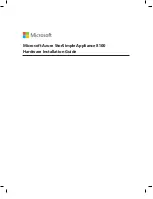
I N S T A L L A T I O N A N D M A I N T E N A N C E M A N U A L
T s u n a m i
F A M I L Y
F A S T E T H E R N E T W I R E L E S S B R I D G E S
J U N E 1 9 9 9
PAGE 3-20
SECTION 3: INSTALLATION & ADJUSTMENTS
3.10 Antenna Installation & Alignment
The antenna installation consists of mounting the antenna on the tower, building roof, or other
location that provides line-of-sight path clearance to the far-end location. In general, antennas
smaller than 2 feet diameter are not recommended for urban areas due to their wider
beamwidths, which results in higher interference susceptibility.
Antennas should be ordered with a suitable mounting kit specific to the site requirements. For
example, specifying round or angle tower leg adapters, or a roof tripod as necessary.
If the antenna is to be mounted indoors, "looking" through a window, it is recommended that the
antenna be placed approximately 12 inches away from the glass and within 10 degrees of a right
angle to the glass. The glass should be lead-free or very low-lead content type and avoid any
metallic glass coatings for best results.
The antenna must be very rigidly mounted, with adequate room for azimuth and elevation
adjustment.
The antenna polarization must be the same at both ends of the link, either vertical or horizontal.
In general, antenna mountings require a support pipe to which upper and lower support brackets
are attached with “U” bolts. The antenna and optional elevation and azimuth adjustment rods are
then mounted onto the support brackets. The whole structure must be adequately grounded for
lightning protection. The antenna system must always be installed according to the manufacturer’s
instructions.
Unless special test equipment is available, two operating
Tsunami
terminals are required to align
the antennas. Alternatively, a CW generator may be used to transmit a signal toward the end
under alignment.
The antenna is coarse aligned using visual sighting and then fine aligned using the receive signal
level (RSL) voltage of the
Tsunami
.
The RSL voltage reading can still be used to peak antennas
even if the radios have not synchronized, however far-end RSL
cannot be measured from the near-end terminal until radios
are synchronized.
To coarse align the antenna, first set it for flat elevation (no up or down tilt) using a spirit level.
Then point it at a heading marker obtained using a compass back-bearing from an adjacent
location, (ideally, 100 feet or more away from the antenna).
Due to the possibility of exposure to RF radiation above the recommended
levels, do not stand within two (2) feet of the antenna for prolonged periods
during system operation. It is the responsibility of the installer to insure that
the antenna is mounted in a place that is not accessible to the public.
Summary of Contents for Tsunami series
Page 1: ...INSTALLATION AND MAINTENANCE MANUAL WIRELESS FAST ETHERNETBRIDGES 5 3 AND 5 8 GHz UNII LE LAN...
Page 2: ......
Page 14: ......
Page 34: ......
















































